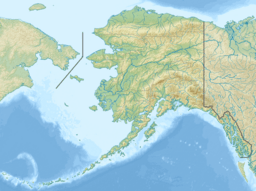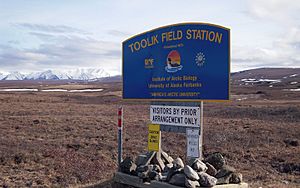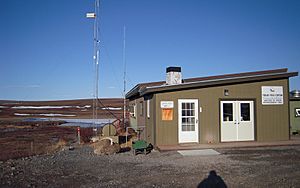Toolik Lake facts for kids
Quick facts for kids Toolik Lake |
|
|---|---|
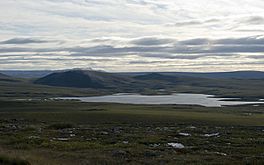
Toolik Lake as photographed in 2016. Toolik Field Station is seen on the left.
|
|
| Coordinates | 68°37′50″N 149°36′38″W / 68.630692°N 149.610636°W |
| Type | Lake |
| Basin countries | United States |
| Managing agency | Bureau of Land Management |
| Surface area | 358 acres (1.45 km2) |
| Max. depth | 77 ft (23 m) |
| Surface elevation | 745 m (2,444 ft) |
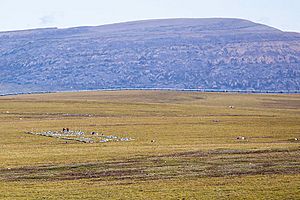
Toolik Lake is a lake in the Arctic region of Alaska, in an area called the North Slope Borough. It's a wild, remote place managed by the Bureau of Land Management. You can reach it by driving on the Dalton Highway.
The lake is about 130 miles (209 km) south of Prudhoe Bay. It sits in the northern part of the Brooks Range mountains. The name "Toolik" comes from the Iñupiat language, where tutlik means yellow-billed loon.
Scientists have been studying Toolik Lake since 1975. Groups like the Global Lake Ecological Observatory Network and NASA do research here. They learn about the lake's water, plants, and animals.
Contents
How Toolik Lake Was Formed
Many lakes and ponds north of the Brooks Range, including Toolik Lake, were made by melting glaciers. Glaciers are like giant rivers of ice. As these huge ice masses slowly moved and then melted, they left behind big holes in the ground. These holes then filled with water, forming lakes.
Lake Size and Water Facts
Toolik Lake covers about 358 acres (1.45 square kilometers). Its deepest point is about 77 feet (23.5 meters). The land area that drains water into the lake is 63.7 square kilometers.
Sunlight doesn't go very deep into the lake. This is because the water has a lot of dissolved organic matter, which makes it a bit dark. The lake can stay frozen with ice on its surface until late June. It might even start freezing again as early as mid-September.
Scientists have noticed some changes in the lake. The water's alkalinity (how well it can handle acids) has doubled since they started recording. Also, there's more dissolved calcium and magnesium flowing into the lake. This happens because the ground, which used to be frozen all the time, is now thawing more. This thawing causes minerals in the soil to break down and flow into the lake.
Animals and Plants of Toolik Lake
Toolik Lake is full of tiny living things called zooplankton. These include very small nanoflagellates, ciliates, rotifers, and copepods. These tiny creatures are an important part of the lake's food web.
There are five types of fish that live in the lake:
People can fish for grayling, trout, and whitefish in the lake.
Plants Around the Lake
The land around Toolik Lake is mostly covered by tussock tundra. Tundra is a type of treeless plain found in cold regions. Other plants in the area include wet sedge tundra and drier heath tundra on higher ground.
You'll find many low-growing shrubs here, like birches and willows. But you won't see any tall trees. Scientists have seen a 19 percent increase in the number of vascular plants (plants with roots, stems, and leaves) around Toolik Lake. The plants are also growing taller and spreading more. However, moss and lichen, which are common in tundra, have decreased a lot.
More than 80 different kinds of birds can be seen near the lake during their spring migration.
Toolik Lake's Climate
For nine months of the year, the average monthly temperatures at Toolik Lake are below freezing. It only gets above freezing in June, July, and August.
During June, July, and August, Toolik experiences the midnight sun. This means the sun never fully sets, so it's light all day and night. In December and January, it's the opposite: the area has 24 hours of darkness. The average amount of rain and snow each year is about 331 millimeters (13 inches).
Lightning strikes have become much more common in northern Alaska since the 1970s. In 2007, a lightning strike started Alaska's biggest recorded tundra fire. This fire happened only 20 miles (32 km) from Toolik Lake.
Toolik Lake Research Natural Area
The Toolik Lake Research Natural Area is a large area of 82,800 acres (335 square kilometers) around the lake. It is managed by the Bureau of Land Management. In 1991, it was named an Area of Critical Environmental Concern. This means it's a special place that needs to be protected.
Two rare plants grow in this area: Claytoniella bostockii and Erigeron muirii. To protect these plants, the Bureau of Land Management and the University of Alaska Museum Herbarium agreed in 2002 to search for rare plants in at least 3,000 acres (1,214 hectares) each year around Toolik Lake and the Galbraith Lake Outstanding Natural Area.
Camping is not allowed in this special area.
Toolik Field Station
The Toolik Field Station is a research center for studying the Arctic. It's located on the southeast shore of Toolik Lake. The University of Alaska Fairbanks (UAF) manages the station.
The station covers about 33.87 acres (13.7 hectares) of land. It can host up to 175 scientists and researchers at a time. The National Science Foundation gives the station $3 million every year to help it operate.
The station has many modern comforts. It has electricity from generators, running water, showers, and even a sauna. There's a kitchen and dining hall, dorm-style rooms for sleeping, heated garages, and labs for chemistry experiments.
Station History
In June 1975, the University of Alaska Fairbanks put the first building on the lake. It was called the "University Toolik Camp." Early research focused on the lake's food chains, how chemicals move through the water, and how nutrients cycle.
By 1979, scientists studying both water and land were working at the site. The research grew to include how fast tundra plants grow and what nutrients they need. The camp quickly became too big for its original spot. So, in 1983, it was moved and given its current name: Toolik Field Station. In 1987, Toolik was chosen as a Long-Term Ecological Research site. This means it's a place where scientists do studies for many years to see how things change over time.
In the late 1980s, Toolik was part of a big project called R4D. This project looked at how tundra ecosystems react to disturbances, like fires or changes in temperature.
Thanks to money from the Department of Energy, the Alaska State Legislature, and the National Science Foundation, the station has been greatly improved since it first started.


